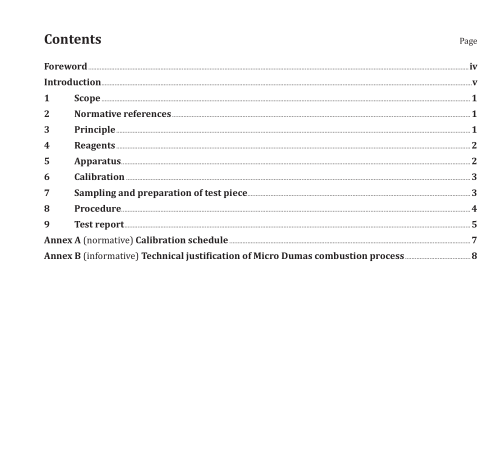BS ISO 19051:2015 pdf download.Rubber, raw natural, and rubber latex, natural — Determination of nitrogen content by Micro Dumas combustion method
5 Apparatus
5.1 Combustion elemental analysers are manufactured in a variety of configurations to suit specific applications and the choice will depend on the elements of interest, the sample type and size, and the concentration of the analyte.
All instruments require two gas supplies: an inert carrier gas (helium recommended) and high purity oxygen (minimum 99,99 %). The strict specification for oxygen and the carrier gas is associated with the need to reduce the nitrogen “blank” contribution to an inconsequential level. Additionally, GC-type gas filters are also usually fitted to prevent trace organic species and water entering the combustion system. The choice of test piece introduction system will depend on the application and the nature of the material.
For solids or viscous liquids, the test pieces are weighed out into tin capsules. For liquids, the test pieces can be sealed in individual aluminium vials or introduced through a liquid auto-sampler. Both capsules and vials are pre-cleaned and dried to avoid trace contamination from oils and water acquired during their manufacture. Instruments are marketed with either simple “one shot” introduction interfaces or a carousel type auto-sampler. In some instances, a microbalance is directly interfaced with the analyser to allow the automatic recording of the weight of each test piece.
The combustion section of the analyser is designed to achieve both complete combustion of the test piece and conversion of oxides of nitrogen to nitrogen gas (N 2 ). Although different approaches have been chosen by different manufacturers, the use of high purity copper is universal for the reduction stage. In some instruments, the combustion and reduction stages are housed in separate furnaces. In others, the reactions are combined in a single two-tier furnace. Catalysts are usually added to the combustion section to aid complete combustion along with absorbents to remove potential contaminants. Both the catalysts/absorbents and copper metal are packed into readily exchangeable tubes made of ceramic material or high quality silica.
The detection system within the analyser can take several forms depending on the combustion mode and test piece size. With small test pieces, the combustion gases can be separated on a GC column and quantified using a thermal conductivity detector. A schematic diagram of such a system is shown in Figure 1. If larger test pieces are required, an instrument employing “frontal” chromatography can be chosen.
The latter approach employs a GC column with thermal conductivity detection but provides a step-wise profile for integration. Other detection approaches do not require a separation step but use separate infrared and thermal conductivity cells to respond to individual elements.
5.2 Analytical balance, capable of weighing to the nearest 0,000 01 g.
5.3 Micro syringe, calibrated.
5.4 Test piece holder, generally, a tin capsule.
6 Calibration
The instrument shall be calibrated in accordance with the schedule given in Annex A.
7 Sampling and preparation of test piece
7.1 For the determination of nitrogen in raw solid rubber, take the laboratory sample in accordance with the method specified in ISO 1795 and prepare the test piece from the laboratory sample. The test piece is to be cut into small thin pieces using suitable tools such as scissors or knife.
7.2 For the determination of nitrogen in raw latex, take the laboratory sample in accordance with ISO 123.
To prepare the dried latex test piece, take an accurately weighed clean and dry aluminium foil dish.
Measure 10 ml from the laboratory sample and put it in the aluminium foil dish. Put the aluminium foil dish in a 110 °C vacuum oven and heat for 15 min until completely dry. Remove the aluminium foil dish from the oven and cool in a desiccator. If the dried sample becomes excessively sticky, sample can be dried at 70 °C ± 2 °C.
A dried latex test piece can also be prepared in accordance with ISO 124:2013, 6.2.
7.3 Weigh the test piece within the range of 0,50 mg to 1,50 mg using the analytical microbalance nearest to 1,00 mg ± 0,01 mg.
7.4 Allow all the weighed test pieces and the analytical microbalance to equilibrate to room temperature for at least 30 min.
7.5 Use a pair of tweezers to place an empty tin capsule on balance and tare the weight.
7.6 Remove the tin capsule using a pair of tweezers and place on metal sample prep block.
7.7 Fill capsule with the desired test piece (generally 0,50 mg to 1,50 mg) and ensure that the test piece is fully encapsulated.
7.8 Tap the encapsulated test piece on a clean surface to remove any remnants on the outside of the encapsulated test piece.
7.9 Place the encapsulated test piece on the balance and record the weight.
7.10 Put the encapsulated test piece in numbered sample tray.BS ISO 19051 pdf download.BS ISO 19051 pdf download
